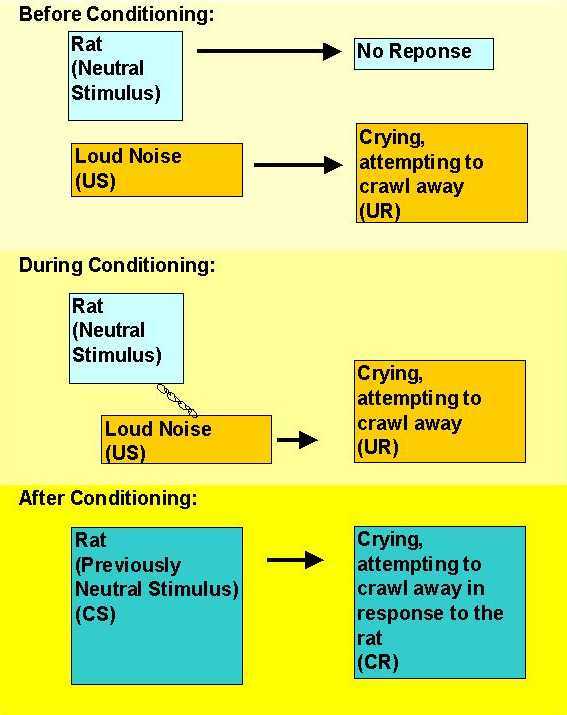
Sometime around the time that Pavlov was doing his research on drooling dogs, John B. Watson was doing his research on conditioning of fear in humans. Watson and Pavlov were separated by an ocean (Watson was at Johns Hopkins University in Baltimore at the time), and it is not clear whether they knew about each others' work, at least initially. (Remember, back then there was no television, no Internet, no mass media as we know it today.) The story of Watson's research on conditioning of fear in humans is commonly referred to as "Little Albert and the White Rat." This story is summarized below.
Little Albert and the White Rat
Once upon a time, in a psychology research laboratory in Baltimore, there worked a young psychologist, John B. Watson, and his lovely assistant, Rosalie Rayner. Watson had already published his "Behaviorist Manifesto" in which he stated that psychology should study only observable behavior. Now he was determined to demonstrate that fears could be conditioned (learned), through ordinary processes involving association of stimuli. Watson had already done extensive research to demonstrate that young children are not naturally afraid of fire or animals. At the time Watson and Rayner began their now-famous study, "Little Albert" was 11 months old. He was described as a remarkably stable infant who rarely displayed fear of anything. He was not afraid of animals, including the white laboratory rat. He was, however, afraid of loud noises (US). Watson and Rayner decided to take advantage of his natural fear response (UR) to loud noises; they wanted to see whether they could condition Little Albert to fear the white laboratory rat (initially, a neutral stimulus), by pairing it with the presentation of a loud noise (US). Watson and Rayner produced the loud noise by striking a large steel pipe with a hammer, just above and behind Little Albert's head. After only seven paired presentations of the rat and the loud noise, Little Albert began to cry and try to crawl away (CR) as soon as he saw the rat (CR), even though the rat was not paired with the loud noise on this occasion. The fear response generalized to other furry objects, including a rabbit, a dog, a fur coat, and a Santa Claus mask. Little Albert had not displayed fear of any of these objects prior to the pairing of the loud noise with the presentation of the rat. Little Albert's fear response to all of these furry objects persisted for over a month while Little Albert remained in the hospital. (However, Watson and Rayner did take steps to "freshen" his responses to the furry objects by pairing them with the loud noise periodically.)
The ending: If Little Albert's fear response behaved just like Pavlov's dogs' salivation response, we would expect that Little Albert's fear of rats and other furry objects would extinguish when they were no longer paired with the loud noise. However, Watson and Rayner indicated that Little Albert left the hospital before they had a chance to see whether they could decondition his response to furry objects. However, we know from subsequent studies that, unlike other conditioned responses, fear responses do not tend to extinguish. The main reason for this is that once people become afraid of something, they tend to avoid it. When they avoid it, there is no opportunity to find out that the thing they are afraid of is not accompanied by the horrible consequence they fear. Because people avoid exposure to things they fear, extinction does not take place, and conditioned fears may persist for a lifetime.
This sequence is summarized in the diagram below:

To read the online version of Watson and Rayner's (1920) paper, click here.
Definitions: